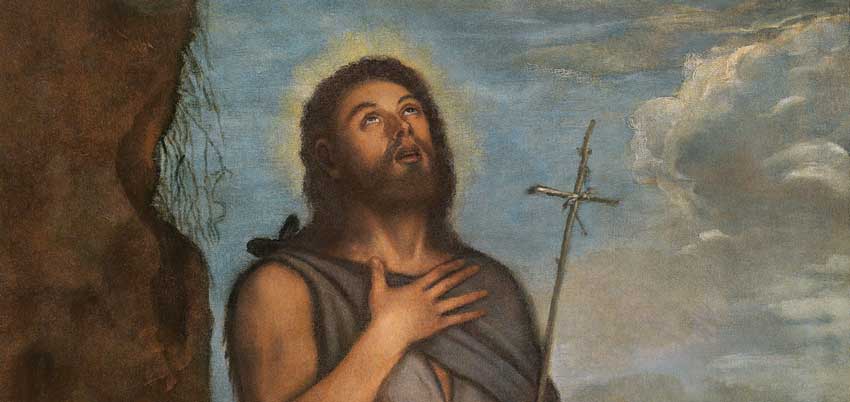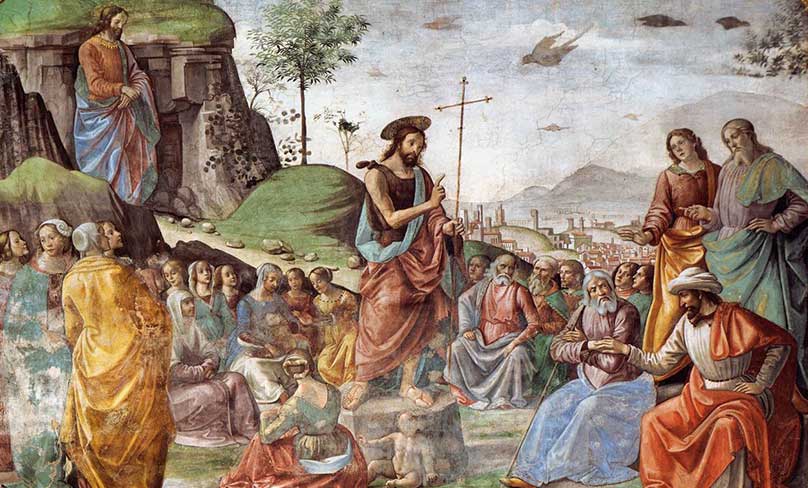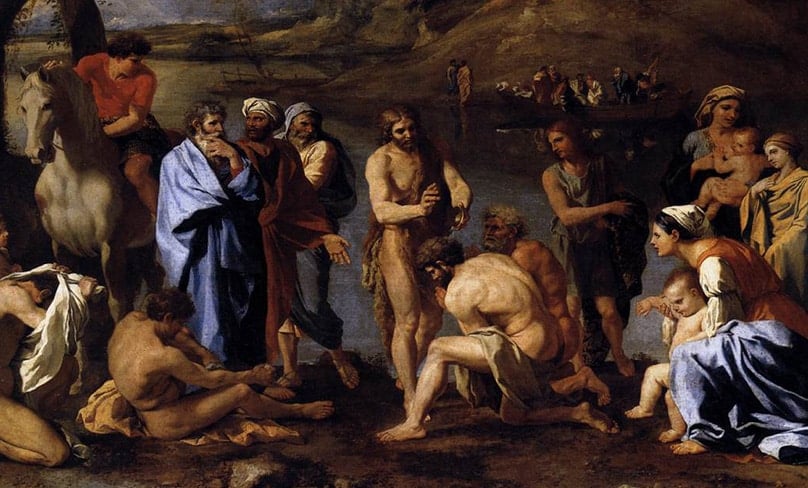 This is Mark’s fourth and final in his series on St John the Baptist for Advent 2018. Click here for Part 1.
This is Mark’s fourth and final in his series on St John the Baptist for Advent 2018. Click here for Part 1.
John the Evangelist’s gospel is chockablock with nuptial imagery. He begins his gospel by carefully drawing our minds back to Genesis with the words “In the beginning” (John 1:1). He then audaciously takes us back not merely to the beginning of creation, but to (if we may speak of it this way) the eternity behind creation. That is, where the Word was with God and the Word was God. Before God said, “Let there be light”, he was eternally speaking the Word who is himself in love and the Word was giving himself back to the Father in love in the unity of the Holy Spirit.
When that Word, in the fullness of time, became flesh and dwelt among us, he came (in John the Evangelist’s telling) in a kind of creation week, since he comes to inaugurate a new creation. So John’s gospel carefully counts off four days beginning with the appearance of John the Baptist in John 1:19 and delineated by markers to separate the days (John 1:29, 35, and 43). Then the evangelist suddenly announces, “On the third day there was a marriage at Cana in Galilee…” (John 2:1). This is typical of the evangelist’s subtle and multi-layered literary art, because it does five things at once.
First, it rounds out the New Creation Week (4+3=7).
Second, in rounding out the New Creation Week and placing Jesus at a wedding, it recalls for us that Jesus is the Second Adam of whom the first Adam was merely a prefiguration.

Third, it reminds us that, by his own preaching, Jesus claims to be the true cosmic Bridegroom (cf. Mark 2:19-20; Matthew 25:1-13).
Fourth, it recalls for us that the public ministry which Jesus is about to begin in the “first of his signs” (John 2:11) is going to culminate in his resurrection “on the third day”.
As to the fifth thing the evangelist is up to, we will discuss that presently.
If you think I’m reading too much nuptial significance into such a simple story, I can confirm it via an ancient, mystical Catholic practice known as “turning the page in my Bible.” Because in John 3, John the Baptist shows up again to say:
He who has the bride is the bridegroom; the friend of the bridegroom, who stands and hears him, rejoices greatly at the bridegroom’s voice; therefore this joy of mine is now full. He must increase, but I must decrease.” (John 3:29-30)
In other words, the Baptist confirms the evangelist’s point: Jesus is the cosmic bridegroom and he is the Best Man.
Now the curious thing about a Best Man at a wedding is that he is there entirely to serve and rejoice over the Bride and Bridegroom. His life, insofar as he is a Best Man, is a referred life. As the Baptist puts it, “He must increase, but I must decrease.” He is simultaneously exalted and diminished by his role as Best Man. He is exalted because no one else gets to be Best Man. He has been chosen by the Bridegroom alone out of the whole human race to stand at the Bridegroom’s side as his champion and greatest celebrant. But at the same time, precisely what he celebrates is a relationship into which he himself does not enter. He becomes greater by bowing out. He heralds the creation of a brand new union that has never existed before in the history of the universe—and it is not union with him.
That is what John the Baptist did too. As the last and greatest of the Old Testament prophets he most clearly articulates not merely their messianic hope but its fulfillment as well. What they announced in figures both obscure and with increasing clarity, he declared plainly and without any veil at all: “I have seen and have borne witness that this is the Son of God” (John 1:34).

Nicolas Poussin, circa 1635. Photo: Wikimedia Commons
That is the secret to understanding Jesus’ peculiarly double-edged praise of John when he says, “I tell you, among those born of women none is greater than John; yet he who is least in the kingdom of God is greater than he” (Luke 7:28). John stands at the very summit of the old covenant’s revelation. And the purpose of that revelation was to point to Jesus. As Jesus himself says first to the disciples on the Emmaus Road:
“O foolish men, and slow of heart to believe all that the prophets have spoken! Was it not necessary that the Christ should suffer these things and enter into his glory?” And beginning with Moses and all the prophets, he interpreted to them in all the Scriptures the things concerning himself” (Luke 24: 25-27)
…and then to the disciples in the Upper Room:
“These are my words which I spoke to you, while I was still with you, that everything written about me in the law of Moses and the prophets and the psalms must be fulfilled.” Then he opened their minds to understand the Scriptures, and said to them, “Thus it is written, that the Christ should suffer and on the third day rise from the dead, and that repentance and forgiveness of sins should be preached in his name to all nations, beginning from Jerusalem” (Luke 24:44-47)
…the whole point of the revelation given to Israel—and culminating in John—is himself, the incarnate God of Israel who “loved the Church and gave himself up for her, that he might sanctify her, having cleansed her by the washing of water with the word, that he might present the Church to himself in splendor, without spot or wrinkle or any such thing, that she might be holy and without blemish” (Ephesians 5:25-27). And indeed, even that image comes from the prophets, who both compare God to a spurned husband (see Hosea and Ezekiel, for example) and who promise that this same husband will “sprinkle clean water upon you, and you shall be clean from all your uncleannesses, and from all your idols I will cleanse you. A new heart I will give you, and a new spirit I will put within you; and I will take out of your flesh the heart of stone and give you a heart of flesh” (Ezekiel 36:25-26).
Which brings us back to that fifth point of the evangelist in his account of the wedding at Cana. Because the Best Man, John the Baptist, heralded the coming of the Bridegroom by sprinkling clean water on the people in a baptism of repentance for the forgiveness of sins and fulfilled all righteousness (as Jesus put it) by doing in a figure what Jesus would do in reality at the climax of his ministry. For the sign of water turned to wine reminds us of the water and blood that gushed from Jesus’ pierced heart (recorded only in John’s gospel), as well as the Eucharistic blood poured out under the appearance of wine. That water is for, the evangelist, nothing other than the waters of baptism. How do we know that? Because the same writer tells us, in his first letter, “There are three witnesses, the Spirit, the water, and the blood; and these three agree” (1 John 5:8).
The Bridegroom whom the Best Man John announced by washing people (including Jesus himself) with the waters of repentance is the second Adam who now creates his Bride the Church from his wounded side the way the first Eve was created from the side of the first Adam. The nuptial pattern is complete and the joy of the Best Man is fulfilled in the Eucharistic Marriage Supper of the Lamb.
And that is why he who is greater than all those born of women is also less than the least in the kingdom of God. It is not a question of some flaw in John (though he would be the first to admit his sins). It is that, in the baptism Christ offers and the pouring out of the Holy Spirit, we become something that the Old Covenant could not offer: partakers in the divine nature (2 Peter 1:4). That is what John came to herald and what the Incarnation of the Son of God at Christmas and his coming passion, death, and resurrection (and the subsequent outpouring of the Spirit at Pentecost) is all about.
